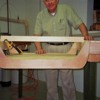When I was in an apartment I had a circular saw, a drill and a jig-saw. (still do actually, but that's not the point).
Even if it's not "technically" the correct tool for all of these jobs, I had better confidence in the cleanliness and accuracy of my cuts using the jig-saw for the plywood, and also the 2x3 legs I used, as well as the 1.25x4 sides I had been using.
I was building small modules (2' x 4' to maybe 2' x 7' max, most were 2' x 6') and they were not cross braced, just straight "4 legs and a table top") using the 1.25 x 4 around the perimeter (so screwed the edges of plywood down to it) and also as a cross-piece at the 4' mark so I had a place to anchor the seam where the plywood transitioned form one piece to another. (I was not using a large single piece for each 2x6 table top, I used 1/4 of a 4x8 and then cut a 2'x2' to make up the difference). All dimensions approximate. I started with cuts at the home store too. A 4x8 sheet cut into quarters.
Point is the jig saw (saber saw, reciprocating saw, take your pick of names - the hand held with the blade that oscillates up and down  )worked well for these kinds of lumber. If you use anything larger where it's got dimensions larger than the blade is long, that would be a problem.
)worked well for these kinds of lumber. If you use anything larger where it's got dimensions larger than the blade is long, that would be a problem.
As to one other item on the list, a second drill (cordless or otherwise) may be helpful so you can drill and use another one with a screwdriver bit. It's a PITA to change the drill bit to the screwdriver bit every time you do a few holes.
A few small clamps to hold wood together while you are in the process of assembly could help too.
Re guides: a level or other straight edge clamped to the plywood can help. If using the jig-saw and going slowly, it has almost no kick (when compared to the circular saw), so you don't necessarily need industrial strength clamps to create a "fence" as strong as one might have on an actual table saw.
You don't mention this, but even in an apartment, 2 saw horses are helpful for layout building, especially when cutting plywood. Have to have it resting on something raised off of the floor while you do the cuts! 
-Dave











